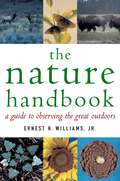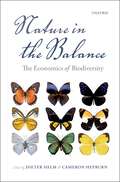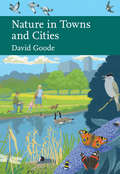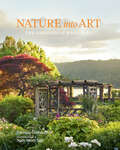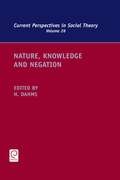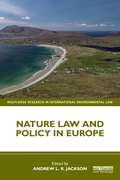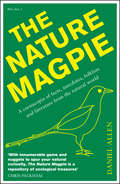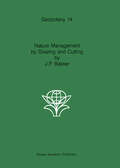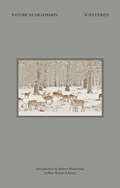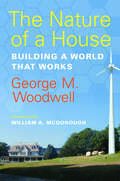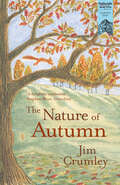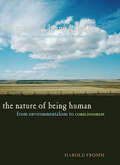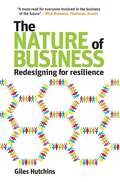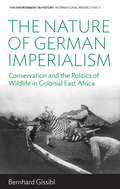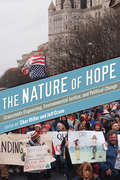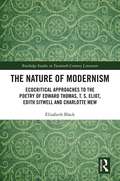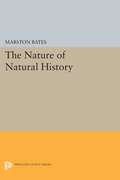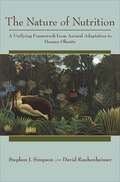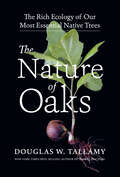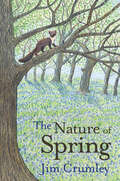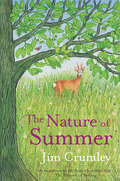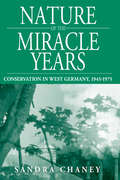- Table View
- List View
The Nature Handbook: A Guide to Observing the Great Outdoors
by Ernest H. WilliamsNature is full of fascinating stories, stories that attract our attention at a young age and keep us amazed throughout our entire lives. The need to understand nature draws us back to its simple beauty again and again, yet underneath this simplicity lies a complex web of associations and patterns. The Nature Handbook does what no other field guide does: explores and explains nature through these connecting patterns, revealing them to the many different types of nature lovers. All naturalists-- from birders to gardeners, hikers to environmentalists, wildflower enthusiasts to butterfliers-- will appreciate the different approach of the Handbook, even those whose interest in the natural world is just beginning to develop. Naturalists who are already well versed in one group of organisms--birders, for example--will find new explanations and patterns for their favorite group, as well as new patterns all around them that they had previously overlooked. Observations in the Handbook are arranged in the three main sections of plants, animals, and habitats. These sections are then connected through discussions of the relationship of size and shape, adaptations, distribution patterns, behavior, and diversity of life. Since the emphasis is on patterns rather than individual species, each chapter has cross-references to related topics. For example, tree-related topics such as leaf shape, treelines, and fall colors, are all discussed in different chapters even though they are related. Leaf shape is associated with trees as organisms, and therefore is in Chapter 2: Trees; treelines are most associated with mountains, so their description is in Chapter 8: Mountains; fall colors apply more broadly to forests than to individual trees, and they are discussed in Chapter 9,Forests. Approximately 500 color photographs help make the more than 200 patterns apparent and recognizable for readers, and each pattern is accompanied by a detailed description and a brief list of sources. The book is designed to invite browsing, and readers will gain a rich ecological perspective and insight. Curiosity about the world around us is a basis for human learning; The Nature Handbook serves to aid all nature lovers in their quest for understanding the many stories that our living world provides.
Nature In The Balance: The Economics Of Biodiversity
by Dieter Helm Cameron HepburnThis book sets out the building blocks of an economic approach to biodiversity, and in particular brings together conceptual and empirical work on valuation, international agreements, the policy instruments, and the institutions. The objective is to provide a comprehensive overview of the issues and evidence, and to suggest how this very urgent problem should be addressed. Whilst there has been an enormous growth and research focus on climate change, less attention has been paid to biodiversity. This collection of high-quality chapters addresses the economic issues involved in biodiversity protection. This book focuses on the economics, but incorporates the underpinning science and philosophy, combining the application of a number of theoretical ideas with a series of policy cases. The authors are drawn from leading scholars in their specific areas of economics, philosophy, and conservation biology.
Nature in Towns and Cities (Collins New Naturalist Library #127)
by David GoodeThe latest in the New Naturalist series documents the parks and green spaces unique to Britain's cities – and the wildlife that has flourished in these habitats.
Nature into Art: The Gardens of Wave Hill
by Thomas ChristopherWave Hill is an iconic public garden located in the Bronx. In this lushly-illustrated, inspirational guide, gardeners will discover the plants and designs that define the garden and learn how to recreate the aesthetic sensibilities at home.
Nature, Knowledge and Negation (Current Perspectives in Social Theory #26)
by Professor Harry F. DahmsThe first emphasis of the volume is on developments in the social theory of environmental issues, the environment, and the environmental crisis. The second emphasis is on the increasingly questionable possibility of shared knowledge at a time of increasing fragmentation of common frameworks, distraction from key issues, and dilution of the idea of objectivity. The thematic emphasis on environmental challenges and issues, includes one contribution on climate change, the resource crunch, and the global growth Imperative, along with critical responses by other experts in this field, and two contributions on the development of planetarian accountancy, and the ubiquity of risk in consumer societies. Further contributions address issues relating to the dialectic of selfhood, the aftermath of postmodernism, limitations inherent to feminist perspectives, the project of public sociology, the fortieth anniversary of Jurgen Habermas' classic, Knowledge and Human Interests, and the need for critical theory to rely on social research.
Nature Law and Policy in Europe (Routledge Research in International Environmental Law)
by Andrew L. R. JacksonThis volume considers current and future challenges for nature law and policy in Europe. Following the Fitness Check evaluation of the Birds and Habitats Directives, in 2017 the EU adopted an Action Plan for nature, people and the economy to rapidly improve the Directives’ implementation and accelerate progress towards the EU's biodiversity targets for 2020. More recently, the EU has adopted a Biodiversity Strategy for 2030 and proposed an EU Nature Restoration Law. This book makes a timely contribution by examining the current state of play in light of recent and historical developments, as well as the post-2020 nature law and policy landscape. While evidence suggests that Natura 2000 and the Habitats and Birds Directives have delivered conservation benefits for wildlife in Europe, biodiversity loss continues apace. The book reviews the requirements for an effective international nature conservation system, with reference to the Birds and Habitats Directives. It examines regulatory regimes, current legal issues in the fields of site protection and species protection, the protection of areas outside Natura 2000, recent developments in the EU and the UK, including the implications of Brexit, agriculture and nature conservation, litigation, science and access to justice. Written by leading experts in the field, from a range of stakeholder groups, the volume draws on diverse experiences as well as providing interdisciplinary perspectives. This volume will be essential reading for students, scholars, practitioners, NGOs and policy-makers interested in European environmental policy and law, including for example lawyers, ecologists, environmental scientists, political scientists, natural resource managers, planners and civil servants.
Nature Law and Policy in Europe (Routledge Research in International Environmental Law)
This volume considers current and future challenges for nature law and policy in Europe. Following the Fitness Check evaluation of the Birds and Habitats Directives, in 2017 the EU adopted an Action Plan for nature, people and the economy to rapidly improve the Directives’ implementation and accelerate progress towards the EU's biodiversity targets for 2020. More recently, the EU has adopted a Biodiversity Strategy for 2030 and proposed an EU Nature Restoration Law. This book makes a timely contribution by examining the current state of play in light of recent and historical developments, as well as the post-2020 nature law and policy landscape. While evidence suggests that Natura 2000 and the Habitats and Birds Directives have delivered conservation benefits for wildlife in Europe, biodiversity loss continues apace. The book reviews the requirements for an effective international nature conservation system, with reference to the Birds and Habitats Directives. It examines regulatory regimes, current legal issues in the fields of site protection and species protection, the protection of areas outside Natura 2000, recent developments in the EU and the UK, including the implications of Brexit, agriculture and nature conservation, litigation, science and access to justice. Written by leading experts in the field, from a range of stakeholder groups, the volume draws on diverse experiences as well as providing interdisciplinary perspectives. This volume will be essential reading for students, scholars, practitioners, NGOs and policy-makers interested in European environmental policy and law, including for example lawyers, ecologists, environmental scientists, political scientists, natural resource managers, planners and civil servants.
The Nature Magpie: A Cornucopia of Facts, Anecdotes, Folklore and Literature from the Natural World (Magpie Ser.)
by Daniel AllenA collection of anecdotes, facts, figures, folklore and literature, The Nature Magpie is a veritable treasure trove of humanity’s thoughts and feelings about nature. With acclaimed nature writer Daniel Allen as your guide, join naturalists, novelists and poets as they explore the most isolated parts of the planet, choose your side – pineapple or durian – in the great 'king of fruits' debate and discover which plants can be used to predict the weather. Meet the roadkill connoisseurs, learn to dance the Hippopotamus Polka, find out the likelihood of sharing your name with a hurricane – and much more.
Nature Management by Grazing and Cutting: On the ecological significance of grazing and cutting regimes applied to restore former species-rich grassland communities in the Netherlands (Geobotany #14)
by Jan P. JanssenNature Near London (Collins Nature Library)
by Richard JefferiesThe Collins Nature Library is a new series of classic British nature writing – reissues of long-lost seminal works. The titles have been chosen by one of Britain’s best known and highly acclaimed nature writers, Robert Macfarlane, who has also written new introductions that put these classics into a modern context.
The Nature of a House: Building a World that Works
by George M. WoodwellIn this candid, charming, and informative book, the director of the renowned Woods Hole Research Center tells a story that will interest anyone who has ever thought about doing a “green” rehab of a building, tried to build green one, or just wonders what’s actually possible.
The Nature of Autumn (Seasons #1)
by Jim CrumleyLonglisted for the Wainwright Prize, a pilgrimage through the shapes and shades of autumn. In autumn nature stages some of its most enchantingly beautiful displays; yet it's also a period for reflection – melancholy, even – as the days shorten and winter's chill approaches. Charting the colourful progression from September through October and November, Jim Crumley tells the story of how unfolding autumn affects the wildlife and landscapes of his beloved countryside. Along the way, Jim experiences the deer rut, finds phenomenal redwood trees in the most unexpected of places, and contemplates climate change, the death of his father, and his own love of nature. He paints an intimate and deeply personal portrait of a moody and majestic season."A delightful meditation." Stephen Moss, The Guardian"Breathtaking…this magical pilgrimage visits enchanting and hidden places…with characteristic moments of close observation, immersion and poetry Crumley witnesses the melancholic textures and haunting transformations of this most beautiful season. This nature book is a delight." Miriam Darlington, BBC Wildlife"Crumley always manages to combine an extraordinary depth of…knowledge with vivid warm writing and a clear love of what he is writing about.…Crumley is one of an endangered species – the real naturalists. Enchanting." Sara Maitland, BBC Countryfile"A cornucopia of autumnal delight." Polly Pullar, The Scots Magazine"A book that quietly celebrates life, at the very moment life is most quietly celebrating itself." Brian Morton, Herald"A love song to earth's reviver and replenisher." Dundee Courier
The Nature of Being Human: From Environmentalism to Consciousness
by Harold FrommAlthough the physical relationship between the natural world and individuals is quantifiable, the psychosocial effect of the former on the latter is often less tangible. What, for instance, is the connection between the environment in which we live and our creativity? How is our consciousness bounded and delimited by our materiality? And from whence does our idea of self and our belief in free will derive and when do our surroundings challenge these basic assumptions? Ecocritic Harold Fromm's challenging exploration of these and related questions twines his own physical experiences and observations with insights gathered from both the humanities and the sciences. Writing broadly and personally, Fromm explores our views of nature and how we write about it. He ties together ecology, evolutionary psychology, and consciousness studies to show that our perceived separation from our surroundings is an illusory construct. He argues for a naturalistic vision of creativity, free will, and the literary arts unimpeded by common academic and professional restraints. At each point of this intellectual journey, Fromm is honest, engaging, and unsparing.Philosophical, critical, often personal, Fromm's sweeping, interdisciplinary, and sometimes combative essays will change the way you think about your place in the environment.
The Nature of Business: Redesigning for resilience
by Giles HutchinsThis enlightening book sets out a new business paradigm to help inspire businesses to thrive.In The Nature of Business, management consultant Giles Hutchins presents the challenges to the prevailing 'business as usual' model, explains the pressing need for transformational change, and reveals the concepts and mindsets necessary to inspire the businesses of tomorrow.Going beyond current approaches to responsible and green business, Hutchins focuses on the emergence of new ways of operating and creating value in an increasingly volatile and interconnected world. He makes the compelling case that the 'Firm of the Future' should seek to mimic behaviours and organisations found in nature, which offer fitting models for businesses capable of flourishing in chaotic and uncertain times. A firm of the future, he argues, builds resilience, optimises, adapts, integrates systems, navigates by values and supports life-building activities. It is a business inspired by nature.Showcasing the pioneers of the new paradigm through examples and case studies, The Nature of Business presents the tools and techniques required to effect the transformation to a business fit for purpose and fit for the future.
The Nature of German Imperialism: Conservation and the Politics of Wildlife in Colonial East Africa (Environment in History: International Perspectives #9)
by Bernhard GissiblToday, the East African state of Tanzania is renowned for wildlife preserves such as the Serengeti National Park, the Ngorongoro Conservation Area, and the Selous Game Reserve. Yet few know that most of these initiatives emerged from decades of German colonial rule. This book gives the first full account of Tanzanian wildlife conservation up until World War I, focusing upon elephant hunting and the ivory trade as vital factors in a shift from exploitation to preservation that increasingly excluded indigenous Africans. Analyzing the formative interactions between colonial governance and the natural world, The Nature of German Imperialism situates East African wildlife policies within the global emergence of conservationist sensibilities around 1900.
The Nature of Hope: Grassroots Organizing, Environmental Justice, and Political Change
by Sophia Cheng Michael Egan Monica Mariko Embrey Cody Ferguson Hugh Fitzsimmons Paul Hirt Jill M. Holslin Anna J. Kim Charles Laurier Bill McKibben Jeffrey C. Sanders Brinda Sarathy Adam M. Sowards Ellen Stroud Adam Tompkins Kyle Powys WhyteThe Nature of Hope focuses on the dynamics of environmental activism at the local level, examining the environmental and political cultures that emerge in the context of conflict. The book considers how ordinary people have coalesced to demand environmental justice and highlights the powerful role of intersectionality in shaping the on-the-ground dynamics of popular protest and social change. Through lively and accessible storytelling, The Nature of Hope reveals unsung and unstinting efforts to protect the physical environment and human health in the face of continuing economic growth and development and the failure of state and federal governments to deal adequately with the resulting degradation of air, water, and soils. In an age of environmental crisis, apathy, and deep-seated cynicism, these efforts suggest the dynamic power of a “politics of hope” to offer compelling models of resistance, regeneration, and resilience. The contributors frame their chapters around the drive for greater democracy and improved human and ecological health and demonstrate that local activism is essential to the preservation of democracy and the protection of the environment. The book also brings to light new styles of leadership and new structures for activist organizations, complicating assumptions about the environmental movement in the United States that have focused on particular leaders, agencies, thematic orientations, and human perceptions of nature. The critical implications that emerge from these stories about ecological activism are crucial to understanding the essential role that protecting the environment plays in sustaining the health of civil society. The Nature of Hope will be crucial reading for scholars interested in environmentalism and the mechanics of social movements and will engage historians, geographers, political scientists, grassroots activists, humanists, and social scientists alike.
The Nature of Modernism: Ecocritical Approaches to the Poetry of Edward Thomas, T. S. Eliot, Edith Sitwell and Charlotte Mew (Routledge Studies in Twentieth-Century Literature)
by Elizabeth BlackThis books presents the first extended study of the relationship between British modernist poetry and the environment. Challenging reductive associations of modernism as predominantly anthropocentric in character and urban in focus, the book’s central argument is that within British modernist poetry there is a clear and sustained interest in the natural world which has yet to receive adequate critical attention. Whilst modernist studies continues to emphasize the plurality of the movement and the breadth of voices and concerns within it, the environmental consciousness of modernist literature and its response to changes to human/nature relations following the experience of war and modernity remain largely unexamined. Exploring British modernist poetry from an ecocritical perspective offers a fresh approach to the movement and its context, and produces original readings of both canonical and more marginalized modernist voices. This book opens by discussing the relationship between modernism and ecocriticism and the benefits of creating a dialogue between the two. It then presents new readings of Edward Thomas, T. S. Eliot, Edith Sitwell, and Charlotte Mew that reveal a shared preoccupation with environmental issues and a common desire to find new ways of achieving physical, psychological, and artistic reconnection with nature. Building on the continuing growth of ecocriticism, this book demonstrates how green approaches to modernist studies can produce new insights into both individual poets and the modernist movement as a whole, making it an essential resource for students of modernism, ecocriticism, and early-twentieth-century literature.
The Nature of Modernism: Ecocritical Approaches to the Poetry of Edward Thomas, T. S. Eliot, Edith Sitwell and Charlotte Mew (Routledge Studies in Twentieth-Century Literature)
by Elizabeth BlackThis books presents the first extended study of the relationship between British modernist poetry and the environment. Challenging reductive associations of modernism as predominantly anthropocentric in character and urban in focus, the book’s central argument is that within British modernist poetry there is a clear and sustained interest in the natural world which has yet to receive adequate critical attention. Whilst modernist studies continues to emphasize the plurality of the movement and the breadth of voices and concerns within it, the environmental consciousness of modernist literature and its response to changes to human/nature relations following the experience of war and modernity remain largely unexamined. Exploring British modernist poetry from an ecocritical perspective offers a fresh approach to the movement and its context, and produces original readings of both canonical and more marginalized modernist voices. This book opens by discussing the relationship between modernism and ecocriticism and the benefits of creating a dialogue between the two. It then presents new readings of Edward Thomas, T. S. Eliot, Edith Sitwell, and Charlotte Mew that reveal a shared preoccupation with environmental issues and a common desire to find new ways of achieving physical, psychological, and artistic reconnection with nature. Building on the continuing growth of ecocriticism, this book demonstrates how green approaches to modernist studies can produce new insights into both individual poets and the modernist movement as a whole, making it an essential resource for students of modernism, ecocriticism, and early-twentieth-century literature.
The Nature of Natural History
by Marston BatesThis classic work is an exploration of what natural history is, and a sustained effort to see how it relates to other areas of biology. Marston Bates did not attempt to overwhelm his audience with facts or overinterpret those he did use, and, perhaps for this reason, The Nature of Natural History is a timeless work. The author's genuine interest in the tropics has a very current feeling, and the first ten or fifteen chapters of the work have a style that is parallel to that of David Attenborough's verbal presentations of nature. From the book: "I have already made several remarks about the connection between parasitism and degeneracy. I suspect this is a matter of point of view. We are predatory animals ourselves, and consequently admire the characteristics of predationagility, speed, cunning, self-reliance. We feel a certain kinship with the lion, and regard the liver fluke with horror. If a sheep were given the choice, though, it might prefer to be debilitated by liver flukes rather than killed by a lion."Originally published in 1990.The Princeton Legacy Library uses the latest print-on-demand technology to again make available previously out-of-print books from the distinguished backlist of Princeton University Press. These editions preserve the original texts of these important books while presenting them in durable paperback and hardcover editions. The goal of the Princeton Legacy Library is to vastly increase access to the rich scholarly heritage found in the thousands of books published by Princeton University Press since its founding in 1905.
The Nature of Nutrition: A Unifying Framework from Animal Adaptation to Human Obesity
by Stephen J. Simpson David RaubenheimerNutrition has long been considered more the domain of medicine and agriculture than of the biological sciences, yet it touches and shapes all aspects of the natural world. The need for nutrients determines whether wild animals thrive, how populations evolve and decline, and how ecological communities are structured. The Nature of Nutrition is the first book to address nutrition's enormously complex role in biology, both at the level of individual organisms and in their broader ecological interactions. Stephen Simpson and David Raubenheimer provide a comprehensive theoretical approach to the analysis of nutrition--the Geometric Framework. They show how it can help us to understand the links between nutrition and the biology of individual animals, including the physiological mechanisms that determine the nutritional interactions of the animal with its environment, and the consequences of these interactions in terms of health, immune responses, and lifespan. Simpson and Raubenheimer explain how these effects translate into the collective behavior of groups and societies, and in turn influence food webs and the structure of ecosystems. Then they demonstrate how the Geometric Framework can be used to tackle issues in applied nutrition, such as the problem of optimizing diets for livestock and endangered species, and how it can also help to address the epidemic of human obesity and metabolic disease. Drawing on a wealth of examples from slime molds to humans, The Nature of Nutrition has important applications in ecology, evolution, and physiology, and offers promising solutions for human health, conservation, and agriculture.
The Nature of Nutrition: A Unifying Framework from Animal Adaptation to Human Obesity
by Stephen J. Simpson David RaubenheimerNutrition has long been considered more the domain of medicine and agriculture than of the biological sciences, yet it touches and shapes all aspects of the natural world. The need for nutrients determines whether wild animals thrive, how populations evolve and decline, and how ecological communities are structured. The Nature of Nutrition is the first book to address nutrition's enormously complex role in biology, both at the level of individual organisms and in their broader ecological interactions. Stephen Simpson and David Raubenheimer provide a comprehensive theoretical approach to the analysis of nutrition--the Geometric Framework. They show how it can help us to understand the links between nutrition and the biology of individual animals, including the physiological mechanisms that determine the nutritional interactions of the animal with its environment, and the consequences of these interactions in terms of health, immune responses, and lifespan. Simpson and Raubenheimer explain how these effects translate into the collective behavior of groups and societies, and in turn influence food webs and the structure of ecosystems. Then they demonstrate how the Geometric Framework can be used to tackle issues in applied nutrition, such as the problem of optimizing diets for livestock and endangered species, and how it can also help to address the epidemic of human obesity and metabolic disease. Drawing on a wealth of examples from slime molds to humans, The Nature of Nutrition has important applications in ecology, evolution, and physiology, and offers promising solutions for human health, conservation, and agriculture.
The Nature of Oaks: The Rich Ecology of Our Most Essential Native Trees
by Douglas W. TallamyDoug Tallamy, the New York Times bestselling author of Nature's Best Hope and Bringing Nature Home, reveals the ecological importance of the mighty oak tree.
The Nature of Spring (Seasons #3)
by Jim CrumleyThird in the Wainwright Prize-listed Seasons TetralogySpring marks the genesis of nature’s year. As Earth’s northern hemisphere tilts ever more towards the life-giving sun, the icy, dark days of winter gradually yield to the new season’s intensifying light and warmth. Nature responds… For our flora and fauna, for the very land itself, this is the time of rebirth and rejuvenation – although, as Jim Crumley attests, spring in the Northlands is no Wordsworthian idyll. Climate chaos and its attendant unpredictable weather brings high drama to the lives of the animals he observes – the badgers, seals and foxes, the seabirds and the raptors. But there is also a wild, elemental beauty to the highlands and islands, a sense of nature in animation during this, the most transformative of seasons. Jim chronicles it all: the wonder, the tumult, the spectacle of spring.
The Nature of Summer (Seasons)
by Jim CrumleyIn the endless light of summer days, and the magical gloaming of the wee small hours, nature in Jim’s beloved Highlands, Perthshire and Trossachs heartlands is burgeoning freely, as though there is one long midsummer’s eve, nothing reserved. For our flora and fauna, for the very land itself, this is the time of extravagant growth, flowering and the promise of fruit and the harvest to come.But despite the abundance, as Jim Crumley attests, summer in the Northlands is no Wordsworthian idyll. Climate chaos and its attendant unpredictable weather brings high drama to the lives of the animals and birds he observes. There is also a wild, elemental beauty to the land, mountains, lochs, coasts and skies, a sense of nature at its very apex during this, the most beautiful and lush of seasons. Jim chronicles it all: the wonder, the tumult, the spectacle of summer.
Nature of the Miracle Years: Conservation in West Germany, 1945-1975 (Studies in German History #8)
by Sandra ChaneyAfter 1945, those responsible for conservation in Germany resumed their work with a relatively high degree of continuity as far as laws and personnel were concerned. Yet conservationists soon found they had little choice but to modernize their views and practices in the challenging postwar context. Forced to change by necessity, those involved in state-sponsored conservation institutionalized and professionalized their efforts, while several private groups became more confrontational in their message and tactics. Through their steady and often conservative presence within the mainstream of West German society, conservationists ensured that by 1970 the map of the country was dotted with hundreds of reserves, dozens of nature parks, and one national park. In doing so, they assured themselves a strong position to participate in, rather than be excluded from, the left-leaning environmental movement of the 1970s.
